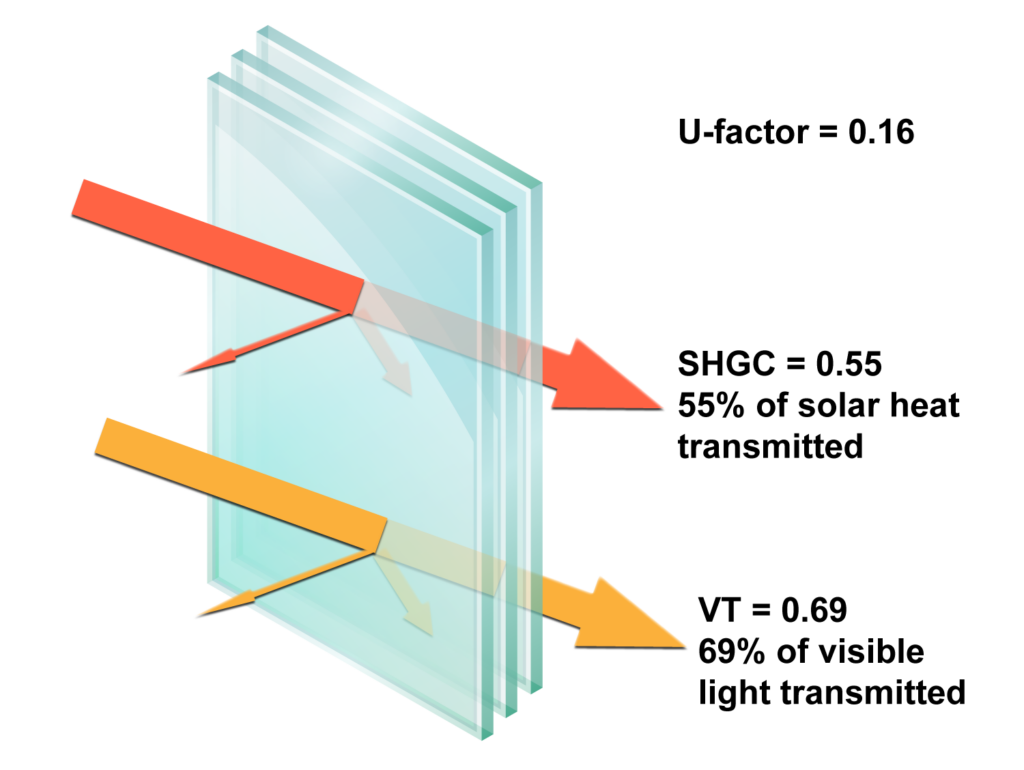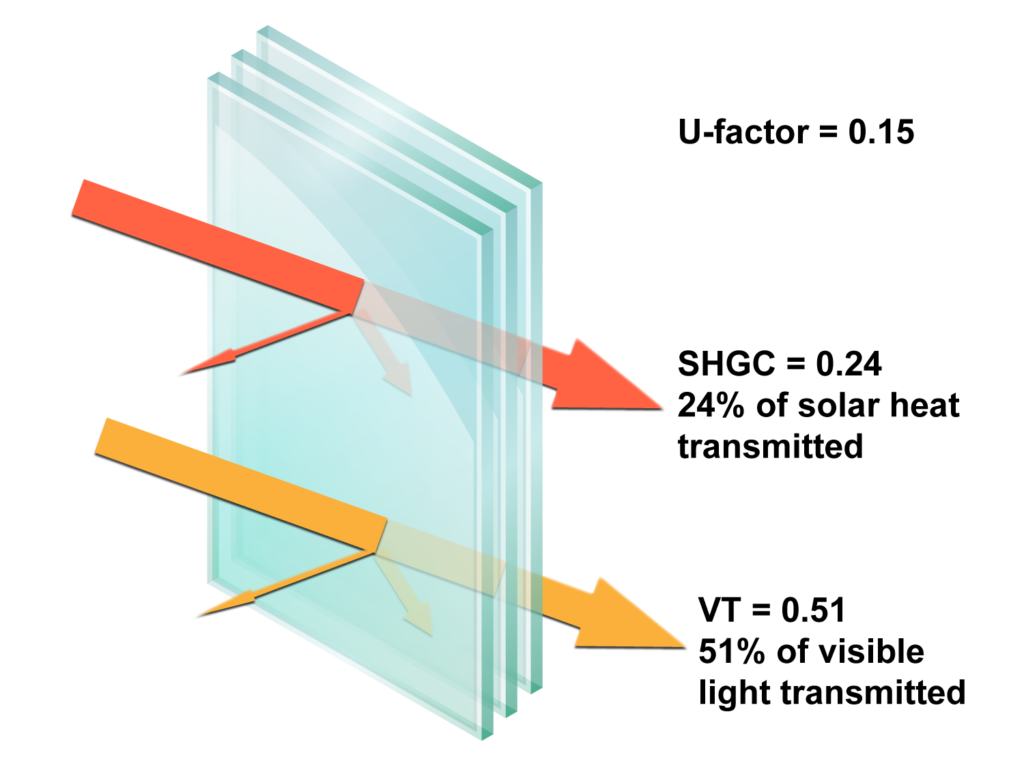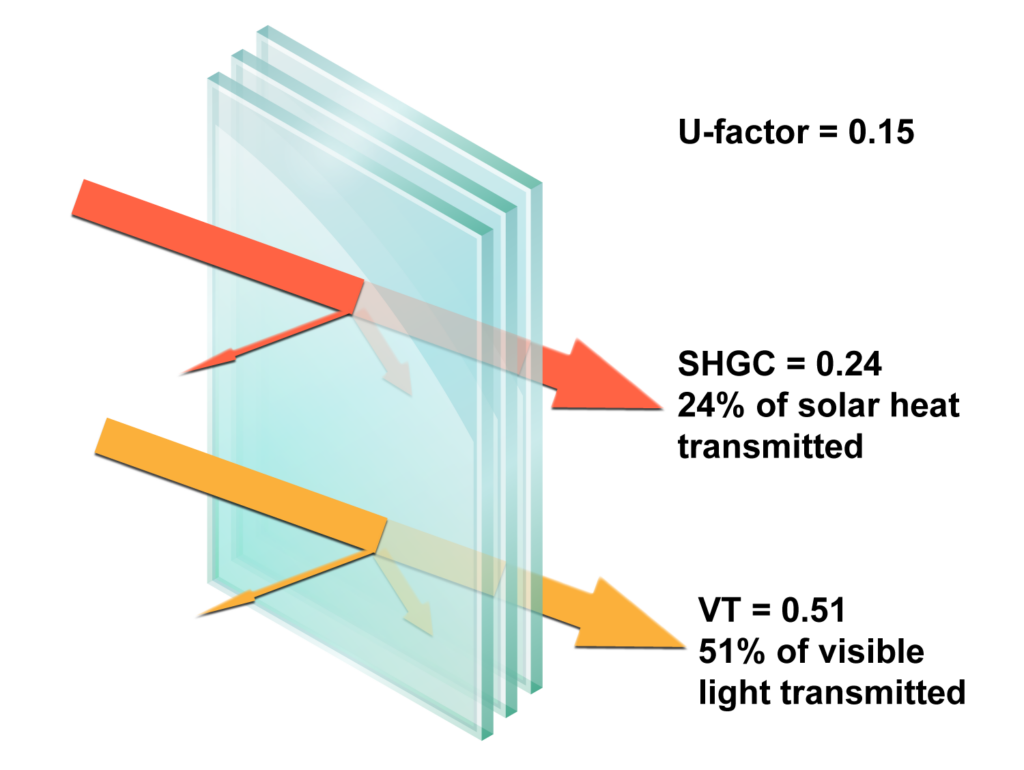
Glazing Types – Triple Low-E Glazing
 Triple-Glazed, High-solar-gain Low-E Glass
Triple-Glazed, High-solar-gain Low-E Glass
This figure illustrates the performance of a window with a very low heat loss rate (low U-factor). In this case, there are three glazing layers and two low-E coatings, ½” argon gas or ¼” krypton gas fill between glazings, and low-conductance edge spacers. The middle glazing layer can be glass or suspended plastic film. Some windows use four glazing layers (two glass layers and two suspended plastic films). This product is suited for buildings located in very cold climates. Both Low-E coatings in this product have high solar heat and visible light transmittance, which is ideal for passive solar design. The use of three layers, however, results in lower solar heat gain relative to double glazing with high-solar-gain Low-E.
High-solar-gain low-E glass is often made with pyrolytic low-E coatings, although sputtered high-solar-gain low-E is also available.
Center of Glass Properties
Note: These values are for the center of glass only. They should only be used to compare the effect of different glazing types, not to compare total window products. Frame choice can drastically affect performance.
Whole Window Properties – Triple-Glazed, High-solar-gain Low-E Glass


Triple-Glazed, Medium-solar-gain Low-E Glass
This figure illustrates the performance of a window with a very low heat loss rate (low U-factor). In this case there are three glazing layers and two low-E coatings, ½” argon gas or ¼” krypton gas fill between glazings, and low-conductance edge spacers. The middle glazing layer can be glass or suspended plastic film. Some windows use four glazing layers (two glass layers and two suspended plastic films). This product is suited for buildings located in very cold climates. Both Low-E coatings in this product have high solar heat and visible light transmittance, which is ideal for passive solar design. The use of three layers, however, results in lower solar heat gain relative to double glazing with high-solar-gain Low-E.
High-solar-gain low-E glass is often made with pyrolytic low-E coatings, although sputtered high-solar-gain low-E is also available.
Center of Glass Properties
Note: These values are for the center of glass only. They should only be used to compare the effect of different glazing types, not to compare total window products. Frame choice can drastically affect performance.
Whole Window Properties – Triple-Glazed, Medium-solar-gain Low-E Glass


Triple-Glazed, Low-solar-gain Low-E Glass
This figure illustrates the performance of a window with a very low heat loss rate low U-factor). In this case, there are three glazing layers and two low-E coatings, ½” argon gas or ¼” krypton gas fill between glazings, and low-conductance edge spacers. The middle glazing layer can be glass or suspended plastic film. Some windows use four glazing layers (two glass layers and two suspended plastic films). With this window, both low-E coatings are spectrally selective in order to minimize solar heat gain. This window is best suited for climates with both significant heating and cooling loads.
Low-solar-gain low-E glass is typically made with sputtered low-E coatings consisting of either two or three layers of silver (also called double-silver or triple-silver low-E).
Center of Glass Properties
Note: These values are for the center of glass only. They should only be used to compare the effect of different glazing types, not to compare total window products. Frame choice can drastically affect performance.
Whole Window Properties – Triple-Glazed, Low-solar-gain Low-E Glass
